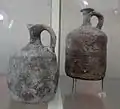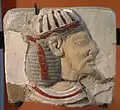Leontopolis (Heliopolis)
Leontopolis (Egyptian: Ney-ta-hut) is the Greek name for the modern area of Tell el Yehudiye or Tell el-Yahudiya (Egyptian Arabic: Jewish Mound). It was an ancient city of Egypt in the 13th nome of Lower Egypt (the Heliopolite Nome), on the Pelusiac branch of the Nile. This site is known for its distinctive pottery known as Tell el-Yahudiyeh Ware.
Ney-ta-hut | |
 Shown within Egypt | |
| Alternative name | Tell el Yehudiye (Jewish mound) |
|---|---|
| Location | Kafr Ash Shubak, Heliopolite Nome |
| Region | Lower Egypt |
| Coordinates | 30°17′41″N 31°20′8″E |
| Type | Ancient location |
| Site notes | |
| Website | Tell el-Yahudiya |
| Ney-ta-hut: 'The Delta site of Tell el-Yahudiya (Mound of the Jews) probably (..) dates to at least as early as the Middle Kingdom and seems to have been occupied right up to the Roman Period. Tell el-Yahudiya was first excavated and published by Naville in 1890, Petrie in 1906 and later investigated by du Buisson for the French Archaeological Institute.' | |
Discovery
| nꜣjj tꜣ ḥ(w)t[1] in hieroglyphs |
|---|
Linant identified the site in 1825,[2][3] but Niebuhr had identified it earlier, in the late 18th century.[4]
Earthwork enclosures
The site includes some massive rectangular earthwork enclosures of the late Middle Kingdom or Second Intermediate Period. They measure around 515m by 490m, and their purpose is probably defensive. These earthen walls were sloping and plastered on the outer face, and almost vertical on the inner face. Egyptian parallels for such a structure are lacking. This enclosure is often interpreted as a fortification built by the Hyksos; it is generally known as the "Hyksos Camp".[5] There are also cemeteries from the Middle Kingdom and later. A temple and palace of Ramesses II has also been excavated. Also, there was a palace of Ramesses III with some fine decorations.
Jewish temple
In the reign of Ptolemy VI Philometor (180–145 BC) a temple, modelled after that of Jerusalem, was founded by the exiled Jewish priest Onias IV.[6] The Hebrew colony, which was attracted by the establishment of their national worship at Leontopolis, and which was increased by the refugees from the oppressions of the Seleucid kings in Judea, flourished there for more than three centuries afterwards. After the outbreak of the Jewish War, the Leontopolite temple was closed in the first century CE, amid the general backlash against Judaism.[7]
Gallery
 Tell el-Yehudiyeh ware juglets. Rockefeller Museum
Tell el-Yehudiyeh ware juglets. Rockefeller Museum Head of an Asiatic prisoner, earthenware, fragment, Tell el-Yahoudiyeh (1184–1153 BCE)
Head of an Asiatic prisoner, earthenware, fragment, Tell el-Yahoudiyeh (1184–1153 BCE) Faience decoration of an enemy. From the palace of Ramses III at Tell el-Yahudiya. Louvre
Faience decoration of an enemy. From the palace of Ramses III at Tell el-Yahudiya. Louvre
| Wikimedia Commons has media related to Tell el-Yahudiya. |
Citations
- Gauthier, Henri (1926). Dictionnaire des Noms Géographiques Contenus dans les Textes Hiéroglyphiques Vol. 3. p. 68.
- Naville, 1890, p5, "the first account... who visited the place in 1825"
- Linant, Memoires, p.139: "Oniosa, Castra Jndceorum. — A 20 kilomètres d'Héliopolis, au nord, on voit un grand monticule de décombres qui sont les restes d'une très-grande ville : ce monticule se nomme Tel-Yeuhoud ou Monticule des Juifs"
- Niebuhr in Egypt, p151-152
- Tell el-Yahudiya at egyptsites.wordpress.com
- Joseph. Ant. Jud. xiii. 3. § 3; Hieronym. in Daniel. ch. xi.
- Joseph. B. Jud. vii. 10. § 4
See also
References
- Manfred Bietak: Tell el-Yahudiya, in: Kathryn A. Bard (Hg.): Encyclopedia of the Archaeology of Ancient Egypt, London/New York 1999, 791–792.
- John S. Holladay Jr.: Yahudiyya, Tell el-, in: D. B. Redford (Hg.): The Oxford Encyclopedia of Ancient Egypt III, Oxford 2001, 527–529.
- Edouard Naville: The mound of the Jew and the city of Onias, London 1890.
- Richard Talbert, Barrington Atlas of the Greek and Roman World, (ISBN 0-691-03169-X), p. 74.
- A.-P. Zivie: Tell el-Jahudija, in: Lexikon der Ägyptologie VI, 331–335.
External links
- Archaeologic survey
- Tell el-Yahudiya at egyptsites.wordpress.com